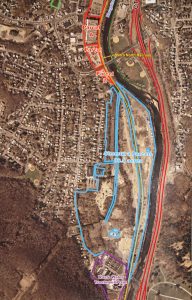
NAUGATUCK — The future of Naugatuck lies in intermodal transportation. At least that is what Mayor N. Warren “Pete” Hess is banking on.
Hess said the borough is working with Pan Am Railways, Inc. and “several very large national and international companies from the New England area” to create an intermodal transportation hub on an 86.5 acre parcel of land along Elm Street.
An intermodal transportation hub is where goods are moved from one source of transportation, such as a train, to another transportation source, such as a tractor-trailer, before reaching their final destination.
Hess believes Naugatuck is the perfect location for such a hub.
“Someone would say why Naugatuck. Well, what’s the southernmost point that you can get that’s close to New York City and New Jersey? It’s right here. So this is the best area to take freight from north to south to distribute it and the closest point to New York, so you can get it here by truck in a short distance and send it north,” Hess said.
Naugatuck Economic Development Corporation President and CEO Ron Pugliese echoed Hess’ comments, saying the borough is the “perfect spot for it.”
“It’s absolutely exciting. The possibility of building something like that that will add to grand list and tax base is a fantastic opportunity for Naugatuck,” Pugliese said. “We are working with the state and individual companies to make this happen.”
The site Hess has in mind is owned by Lanxess, which was formally Chemtura.
Pan Am owns freight lines that extend to the site. Since Pan Am has rail lines that extend as far north as Canada and as far south as southern Connecticut, it would make sense to use the rail line to transport goods and take trucks off the road, Hess said.
Hess envisions that goods would be shipped via freight trains to the site on Elm Street where they would be unloaded into warehouses on site then loaded onto trucks to be delivered.
The trains would use the freight lines, which include part of the Metro-North Railroad commuter line that Pan Am has access to, to deliver the goods, Hess said.
“Someone could ask is the freight going to interfere with the passenger. No because the freight trains are going to come late at night when no one is using the passenger lines, unload and go from there,” Hess said.
The transportation hub would also help companies that are coming from Europe looking to ship goods north, Hess said. Currently, shipments are loaded onto trains in New York, he said.
“When you are in the New York City you have to maneuver through several sets of train lines to get out. You can’t just land in New York City, get on the train and go direct to Boston. You would have to change several trains, which means changing your cargo several times and negotiating different rates. So, from the converse, when goods come by ports to New York City or Newark, those goods would be sent by truck to Naugatuck and then would go north by train to New England or Canada,” Hess said.
Since the Metro-North rail line is equipped to carry freight trains, Hess said, the only infrastructure the borough would have to build is a rail spur that lets trains pull into the property and to unload the cargo.
The spur would be on the western side of the rail line near the Naugatuck River, Hess said.
There are a couple hurdles the borough must clear in order to bring this project to fruition, however.
“There are a lot of moving parts and a lot of issues,” Hess said.
The biggest is that the borough doesn’t own the land.
Hess said officials are in talks with representatives from Lanxess.
Another issue is that the land, which served as the home of the Uniroyal Inc. complex, is contaminated.
Hess said Lanxess has done environmental tests on the property and that remediation work is ongoing.
“There is a lot that has already been done, there is a lot being done now, and there is more that will happen before this is finalized,” Hess said.
A message left with Lanxess seeking comment wasn’t returned as of press time.
Intermodal transportation isn’t a new concept.
According to the Intermodal Association of North America, intermodal transportation began in America in the 1950s. The association estimates that 95 percent of the world’s manufactured goods, at some point, travel intermodally before arriving in the hands of the customer, the association’s website states.
“This is not unique to Naugatuck. This is the wave of the future for transportation all across the country. It’s the way business will be done in the future,” Hess said. “It just so happens, because of Naugatuck’s location to New York, the Tri-State area, and the rail line, we have the best location.”














These idiots that run this town can’t even settle any issues concerning Parcel C… and their going to build this monstrosity… give me a flipping break.